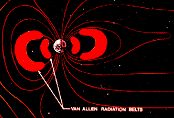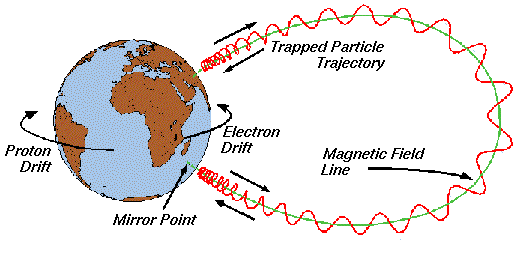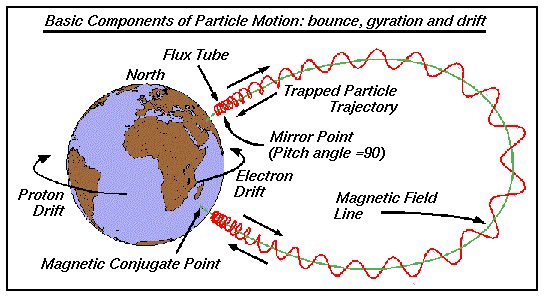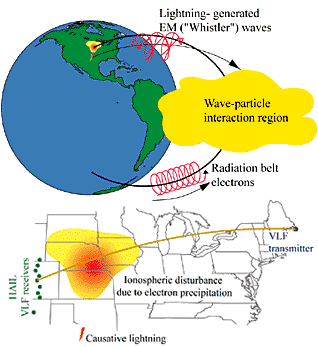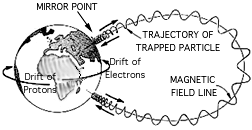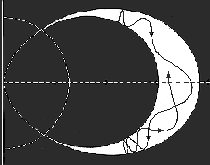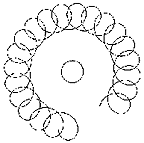from: The
Van Allen Belts:
http://image.gsfc.nasa.gov/poetry/tour/vanallen.html)
Van
Allen's first drawing
When somebody is learning something about the planet Earth
so the chance is relatively big that in the book is a
strange picture like this:
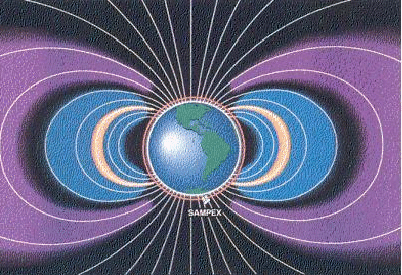
Planet Earth with the Van Allen radiation belts,
coloured diagram.
The foto here shows the Earth which
is covered by clouds of invisible particles. These
particles are painted here by an artist in violet and
pink. The book will tell you that the violet parts and
the pink parts are Van Allen radiation belts.
The "belts" are an example for particles which are
captured in the terrestrial magnetic field like flies in
a bottle when they fall into it. Though the artists
paint the belts like this as if the belts would consist
of dense gas clouds the belts are this diluted that
astronauts cannot see or feel them when they are
performing an atmosphere-walk out of an atmosphere ship.
The radiation belts are this diluted that the scientists
did not know of them until sensitive instruments in
satellites detected them in the late 1950ies.
After this the scientists as Prof. James van Allen at
the Iowa State University was bothering with the
particles, the cosmic radiation. Other physicians had
detected them already in the 1930s.
What are the particles? Where they
come from?
As soon the satellites were built and could perform
their Earth orbits van Allen and his team integrated an
instrument in the satellites to measure the particles
(e.g. Explorer I and Pioneer 3). They detected that the
data was very different to the expected data. When the
satellite was in his orbit the instruments
registered a changing stream of cosmic radiation
particles along the orbit. The change of the
streams was not by chance.
Drawing the streams in a diagram corresponding to the
intensity there is this drawing coming out. The team
about van Allen detected which the data of several
satellites that there were real clouds of particles with
very high energetic particles near the Earth. These
clouds had a certain form. At the equator level they
were most massive, near the poles they were very thin.
The drawing shows the radiation belts with the flying
path of "Pioneer 3".
This is Van Allen's drawing of the inner and the outer
radiation belt after receiving the data of satellite
"Pioneer 3". This was the drawing in the "Nature"
magazine in 1959 by J.A. van Allen and L.A. Frank.

Van Allen radiation belts, extension, incomplete
drawing.
|
The detection of the first two Van
Allen belts
|
|
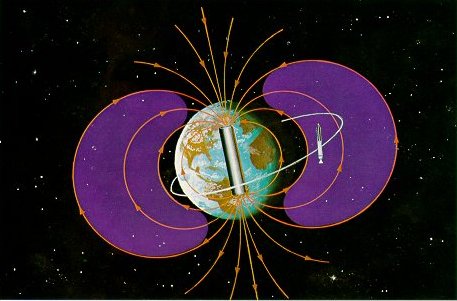
Inner Van Allen belt which is detected by
Explorer 1. Coloured diagram.
|
First the scientists
thought that the Earth is flying in an almost
empty room an the magnetic field would leave
it's traces as a pattern which resembles to a
magnetic field (orange lines). But the first
"American" satellite, Explorer 1, detected a
ring with energetic particles which were
captured over the Earth and were moving within
the fields. It was the first of two such zones,
the Van Allen belts, which were found.
|
|
The next satellites detected
another, an exterior Van Allen belt, black and
red diagram.
Inner and outer Van Allen belt,
real space diagram with the presentation of
the cosmic radiation ("sunwind") and with the
compression of the Van Allen belts in the
direction of the sun. On the "shadow side" the
outer Van Allen belt is protracted.
|
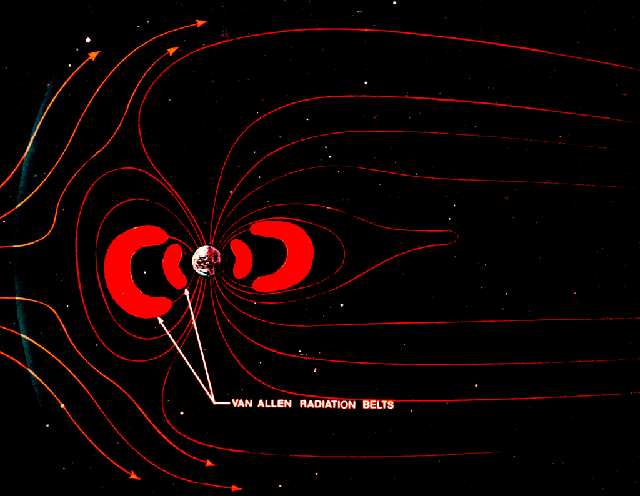
|
|
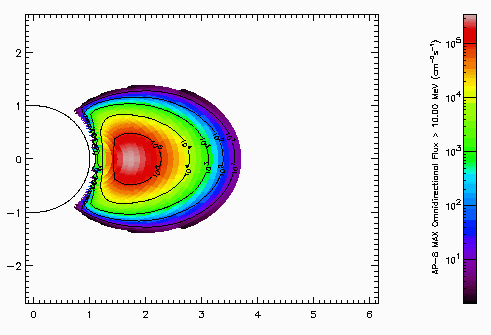
|
Inner
Van Allen radiation belt with protons: Diagram
with the particle speed, coloured schema.
Trapped proton belt. From AP-8 MAX (SPENVIS) |
|
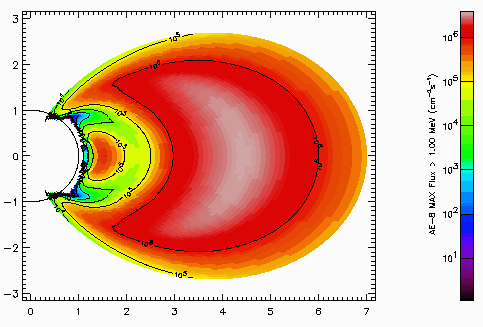
|
Outer
Van Allen belt with electrons: Diagram with
particle speed, coloured schema.
Trapped electron belt. From AE-8 MAX (SPENVIS) |
|
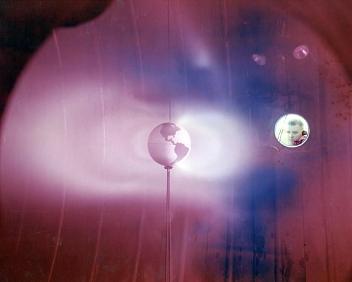
|
Simulation
of the Van Allen belts
generated by plasma thruster in
tank #5 Electric Propulsion Laboratory at the
Lewis Research Center, Cleveland Ohio, now
John H. Glenn Research Center at Lewis Field.
(Picture 5. See Credits below)
NASA foto no.: c1966-3654
http://grin.hq.nasa.gov/BROWSE/ALLGRIN_97.html
http://grin.hq.nasa.gov/IMAGES/SMALL/GPN-2000-002003.jpg
|
Van Allen was a little surprised to
detect new belts around the Earth because he had not
looked for them. He had looked for another phenomenon in
nature, the cosmic radiation. At the same time another
team had looked for the belts already but they were not
sure what kind of particles it would be, and what energy
could be expected.
To learn more about why they are such
a hazard to astronauts
and satellites, let's take a closer look at
them!
Detailed studies by satellites of the last 50 years show
that there are actually two kinds of already known
particles which build the belts: Electrons an protons.
The single particles bear much energy and it's useful to
name the energies with the normal energy designations.
The detection of the third Van Allen
belt
|
There are two electron
belts and one proton belt (so there are
three "Van Allen belts").
The proton belt
(blue)
begins with about 500 km
over the Earth and is extends up to a height
of 13,000 km. This inner belt contains
protons with an energy of over 10 mio. Volt.
Scientists mean today that these protons are
trapped cosmic radiation particles from out
of the solar system or they are trapped by
the sun itself, during heavy son glinting.
The low energy electron belt (pink)
overlapping the space of the proton belt. The
electrons bear an energy average of 1 to 5
mio. volts.
Third high
energetic electron belt (violet)
is further out in space and in the diagram the
violet belt. The electrons in this outer belt
bear an average of 10 to 100 mio. volt.
|
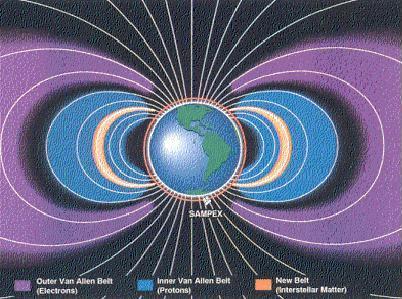
Three
Van Allen belts, coloured diagram:
-- blue: Inner Van Allen belt (protons)
(voltage per particle: over 10 mio. volt)
-- pink: New Van Allen belt (electrons)
(voltage per particle: 1 to 5 mio. volt)
-- violet: Outer Van Allen belt (electrons)
(voltage per particle: 10 to 100 mio.
volt).
|
A modern mystery
[Where
are coming from the high particle energies between 1 and
100 mio. volt?]
There are some questions about the belts yet until today.
Even today the space physicians cannot understand
completely where the particles come from or how the
energies of the particles can be this "astronomical" in
comparison to the plasmaspheric particles or to the ring
formed voltage particles. Typical "ring" particles consist
of electrons and protons with energies between 1 and 100
mio. volt. Energetic ring current particles only have
seldom more than 150,000 volt energy.
[The
movement of the particles from pole to pole in a drift]
As the plasma movement the particles are tending to move
from pole to pole and to drift from East to the West at
the same time. The particles of the Van Allen belts are
doing the same. Instead of drawing the clouds as soft
donuts it would be more correct to draw the clouds as
sharp "horns" which have their ends on the poles. On the
points of the horns the particles hit neither the
atmosphere and are lost for the belts, or they are
rejected along the magnetic field into space.
[The
radiation abnormality of the nearer belts over South
"America" and over the South Atlantic]
There is one more aspect about the belts which is
especially interesting for the manned atmosphere flight
and the satellites. Because of a shift of the magnetic
field corresponding to the Earth axis the influence in the
equatorial regions over South "America" is bigger. Because
the belt is following the Earth magnetic field and not the
oblique rotation axis of the Earth, this means that the
belt is nearer to the Earth's surface over South "America"
and over the Southern Atlantic.
[The inner Van Allen belt inclines to the South Atlantic
resp. the Earth at the South Atlantic is inclining to the
Inner Van Allen belt].
This means that a stay in a Space Shuttle, in an
atmosphere station or that a functioning satellite over
the South Atlantic is nearer to the belts and gets a
higher radiation dose from the belts, because the
particles penetrate the atmosphere ship or the casing of
the satellite. This region is called the South Atlantic
abnormality. This concerns radiation doses at astronauts
as also the data transmission quality of atmosphere ships
passing this region.
The abnormity
of the radiation belts over the South
Atlantic (SAA)
|
 |
Diagram of the inner Van Allen
belts with the approximation at the South
Atlantic, coloured schema.
SAA close up in orbit. From
http://www.estec.esa.nl/wmwww/wma/rad_env.html |
|
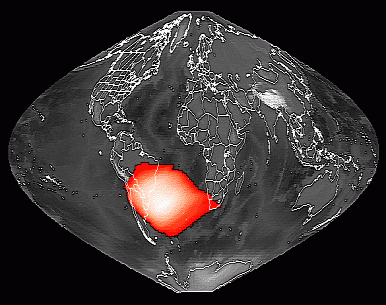
|
Abnormity of the radiation belt
over the South Atlantic, diagram with an Earth
foto.
SAA. From
http://www.estec.esa.nl/wmwww/wma/rad_env.html |
|
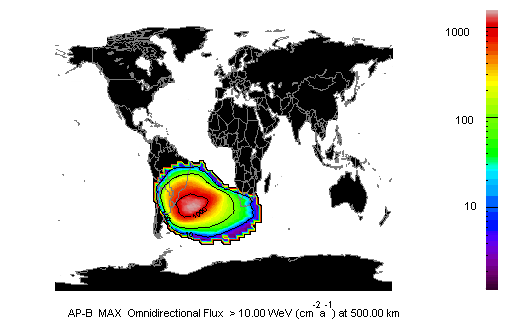
|
Abnormity of the radiation belts
over the South Atlantic with indication of
speed of particles, coloured schema.
South Atlantic Anomaly. From AP-8 MAX (SPENVIS) |
|

|
Abnormity of the South Atlantic
of the inner Van Allen radiation belt over the
South Atlantic (SAA), with indication of the
speed of the particles, schema in black and
white.
SAA at surface. Intensity map. From
http://www.estec.esa.nl/wmwww/wma/rad_env.html |
|
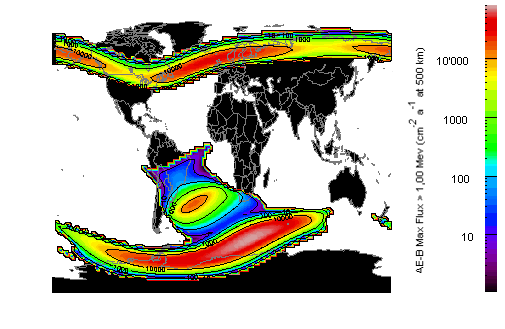
|
Inner and outer radiation belt
with the abnormity of the radiation belt over
the South Atlantic (SAA) with indication of
the speed of the particles, coloured schema.
SAA and electron distribution. From AE-8 MAX
(SPENVIS) |
Humans were hit by the belt particles,
but never that much as some people believe. Astronauts
in a Space Shuttle an in an atmosphere ship receive
every time when they pass the South Atlantic (SAA) about
2 mRems additional dose. In one week this is an addition
of 7 times 30 = 210 mRems. This is the dose of a year on
the ground (about 350 mRems).
[Moon travel seems not possible]
To pass the belts the astronauts need about 30 minutes.
One travel is a dose as it is in Space Shuttle (TBD).
NASA claims the moon landings were true because NASA
claims that the protection shield was thick enough. And
the high energetic particles are very seldom.
[But what's with 1 to 100 mio. volt? NASA is not
explaining, and it seems impossible passing these
particles].
[Shooting star traces]
The astronauts report about "shooting stars" (TBD?).
These were caused by high energetical particles. The
particles go by the fluid in the eye and leave behind a
bright an fast light trace. Similar stripes were
reported from astronauts in the Space Shuttle, and also
astronauts of other missions near the Earth during solar
storms reported this. It's not known how the long term
consequences of that kind of the short exposure will be
with the astronauts.
NASA means that a trip to the Mars is possible and there
will be much more shooting traces. [But even a moon trip
is not possible because of radioactivity in space].
Humans also have a significant influence on the belts by
their nuclear programs. During the nuclear tests there
were new belts created, in the "notch" region precisely
at the other side of the proton belt. This temporary
belt is eventually dissolved, but traces could be
detected even in the 1980ies yet.
Conclusions of Michael Palomino: No "moon
landings" because of the voltage and the radiation
With a voltage of 1 to 100 mio. volt and higher and with
radioactive radiation "moon flights" are said having
been possible. But the radiation of the moon itself
without protecting atmosphere has also to be considered.
So, the "moon landings" were not possible.
This is NO conspiracy theory, you stupid NZZ, but this
is logic.
Picture
sources
-- Van Allen belts:
http://image.gsfc.nasa.gov/poetry/tour/vanallen.html
^



